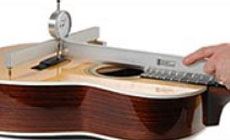Top Deflection Gauge Instructions
How to use the Top Deflection Gauge for neck resetting and saddle routing, banjo head tensioning, and assessing and adjusting neck relief.
The Top Deflection Gauge is an aluminum beam with a dial indicator that reads in thousandths of an inch mounted in the center. Three holes on each end of the beam are for positioning the feet of the tool for spanning various lengths. The swiveling foot lets the tool stand without being held. When the strings are removed from a guitar, the top can fall or sink downward a little, or a lot. It's important to compensate for this distance when resetting a neck or when routing a bridge saddle slot. To raise the top, use a brace jack on the inside of the guitar. Rest on a piece of wood that spans the braces. The jack gently pushes the bridge area up to the position it was in under standard tension. Above: a brace jack raises the top to simulate string tension during bridge and neck reset work. Simulating string tension eliminates guesswork during a reset, and guarantees a flat saddle slot bottom when routing (especially important when installing an under-saddle transducer). 1. With strings on and tuned to pitch, rest the feet of the gauge as close to the outside rim of the guitar as possible. 2. Center the indicator plunger over the appropriate area of the bridge. Zero the gauge, and then set the gauge aside while you remove the strings. 3. Place the gauge back in position (if the top has moved, the gauge should not read zero). Raise the brace jack until the indicator reads zero. This simulates the top at normal string tension. 4. Do the work (neck reset, saddle rout or other work dependent on top deflection) with the strings off. Remove the brace jack, restring, and there should be no surprises when the instrument is tuned to pitch. The Top Deflection Gauge is very helpful in tensioning a banjo head to get the desired tone. 1. Zero the tool on a granite plate or other flat surface. 2. Position it on a banjo strung to pitch so that the feet are at the edge of the head, and the indicator tip is close to and near the center of the bridge. The reading on the indicator is the deflection of the head. In this case, the top is deflected down .070" from string tension. Notice that the dial can turn either way. If it is turning clockwise, use the larger black numbers. If the dial is turning counterclockwise from the zero position, use the smaller red numbers. In this case it is turning counterclockwise, so we are using the smaller red numbers. 3. Tighten or loosen the bracket nuts to raise or lower the tension and thus change the tone of the banjo head. This gauge can be used to read an especially good sounding banjo and that information used to tune the head on your instrument. 1. Zero the indicator on a flat surface, or against an accurate straightedge. 2. Place the Deflection Gauge anywhere on the fretboard and read flatness of the fingerboard. If the indicator reads on the clockwise side of zero the neck is back-bowed. If it reads to the counterclockwise side, the neck is up-bowed or has some relief. 3. With a good two-way truss rod you should be able to adjust it flat from either condition. Try to hold the gauge as vertical as possible. Due to the shape of the indicator's cap, slight tipping from side to side will not affect the tool's readout. When the feet are in the holes closest to the center of the tool, it can be used to read all over the fretboard and check for uneven places so a decision can be made on whether or not to plane the board. For the greatest accuracy, take these measurements with the guitar resting on its side in the playing position. This is the way to measure and adjust fretboard action, instead of laying the guitar on its back (as we’ve done in the photo) with gravity pulling the neck and strings downward. Our Erlewine Neck Jig (#5399) is a great tool for holding and tilting the guitar for reading and accurately adjusting a neck. This tool is only for reading the fretboard, and is not able to read the fret tops. To read the fret tops, use our Neck Relief Gauge (#2004) which is designed for setting neck relief with the truss rod at final set-up.
Neck resetting and saddle slot routing



Banjo head tensioning

Reading and adjusting neck straightness or relief

